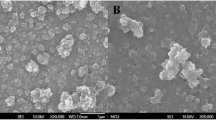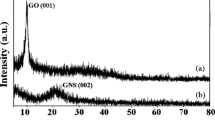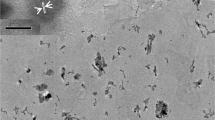Abstract
Herein, we present a simple and facile synthesis strategy of porous N-doped graphene (N-Gr) using a facile one-step pyrolysis method. The as-prepared N-Gr was characterized by power X-ray diffraction, scanning electron microscopy, transmission electron microscopy, and X-ray photoelectron spectroscopy. N-Gr-modified glassy carbon electrode exhibited a lower overpotential and the higher redox peak currents for catechin during the electrochemical reaction of catechin. At the N-Gr-modified electrode, the redox process of catechin was almost reversible and displayed an adsorption-controlled redox process with a fast electron transfer rate. The linear responses of the sensor for catechin have been obtained by the differential pulse voltammetry in the range from 1.0 to 30 μM with the calculated detection limit of 0.088 μM (S/N = 3). The real application of catechin in Chinese green tea samples with excellent performance such as long-term stability and good reproducibility was successfully achieved.









Similar content being viewed by others
References
Devadas B, Chen SM (2015) Controlled electrochemical synthesis of yttrium (III) hexacyanoferrate micro flowers and their composite with multiwalled carbon nanotubes, and its application for sensing catechin in tea samples. J Solid State Electrochem 19:1103–1112
Ananingsih VK, Sharma A, Zhou W (2013) Green tea catechins during food processing and storage: a review on stability and detection. Food Res Int 50:469–479
Chu KO, Wang CC, Chu CY (2004) Determination of catechins and catechin gallates in tissues by liquid chromatography with coulometric array detection and selective solid phase extraction. J Chromatogr B 810:187–195
Masoum S, Behpour M, Azimi F, Motaghedifard MH (2014) Potentiality of chemometric approaches for the determination of (+)-catechin in green tea leaves at the surface of multiwalled carbon nanotube paste electrode. Sensors Actuators B Chem 193:582–591
Wu J, Wang H, Fu L, Chen ZP, Jiang JH, Shen GL, Yu RQ (2005) Detection of catechin based on its electrochemical autoxidation. Talanta 65:511–517
Janeiro P, Brett AMO (2004) Catechin electrochemical oxidation mechanisms. Anal Chim Acta 518:109–115
Fernandes SC, Osório R, dos Anjos A, Neves A, Micke GA, Vieira IC (2008) Determination of catechin in green tea using a catechol oxidase biomimetic sensor. J Braz Chem Soc 19:1215–1223
Wang XG, Li J, Fan YJ (2010) Fast detection of catechin in tea beverage using a poly-aspartic acid film based sensor. Microchim Acta 169:173–179
El-Hady DA, El-Maali NA (2008) Determination of catechin isomers in human plasma subsequent to green tea ingestion using chiral capillary electrophoresis with a high-sensitivity cell. Talanta 76:138–145
Yin XL, Wu HL, Gu HW, Zhang XH, Sun YM, Hu Y, Liu L, Rong QM, Yu RQ (2014) Chemometrics-enhanced high performance liquid chromatography-diode array detection strategy for simultaneous determination of eight co-eluted compounds in ten kinds of Chinese teas using second-order calibration method based on alternating trilinear decomposition algorithm. J Chromatography A 1364:151–162
Danila AM, Kotani A, Hakamata H, Kusu F (2007) Determination of rutin, catechin, epicatechin, and epicatechin gallate in buckwheat Fagopyrum esculentum Moench by micro-high-performance liquid chromatography with electrochemical detection. J Agric Food Chem 55:1139–1143
Araya-Farias M, Gaudreau A, Rozoy E, Bazinet L (2014) Rapid HPLC-MS method for the simultaneous determination of tea catechins and folates. J Agric Food Chem 62:4241–4250
Jin JQ, Ma JQ, Ma CL, Yao MZ, Chen L (2014) Determination of catechin content in representative Chinese tea germplasms. J Agric Food Chem 62:9436–9441
Guillarme D, Casetta C, Bicchi C, Veuthey JC (2010) High throughput qualitative analysis of polyphenols in tea samples by ultrahigh pressure liquid chromatography coupled to UV and mass spectrometry detectors. J Chromatogr A 1217:6882–6890
Gomes SASS, Rebelo MJF (2003) A new laccase biosensor for polyphenols determination. Sensors 3:166–176
Yao YY, Zhang L, Wen YP, Wang ZF, Zhang H, Hu DF, Xu JK, Duan XM (2015) Voltammetric determination of catechin using single-walled carbon nanotubes/poly(hydroxymethylated-3,4-ethylenedioxythiophene) composite modified electrode. Ionics 21:2927–2936
Thanh TD, Balamurugan J, Lee SH, Kim N, Lee JH (2016) Effective seed-assisted synthesis of gold nanoparticles anchored nitrogen-doped graphene for electrochemical detection of glucose and dopamine. Biosen Bioelectron 81:259–267
Geim AK (2009) Graphene: status and prospects. Science 324:1530–1534
Ambrosi A, Chua CK, Bonanni A, Pumera M (2014) Electrochemistry of graphene and related materials. Chem Rev 114:7150–7188
Gai PP, Zhao C, Wang Y, Abdel-Halim ES, Zhang JR, Zhu JJ (2014) NADH dehydrogenase-like behavior of nitrogen-doped graphene and its application in NAD+-dependent dehydrogenase biosensing. Biosen Bioelectron 62:170–176
Wang Y, Shao Y, Matson DW, Li J, Lin Y (2010) Nitrogen-doped graphene and its application in electrochemical biosensing. ACS Nano 4:1790–1798
Wang YL, Zhang XM, Li AN, Li MG (2015) Intumescent flame retardant-derived P,N co-doped porous carbon as an efficient electrocatalyst for the oxygen reduction reaction. Chem Commun 51:14801–14804
Wu TX, Wang GZ, Zhang X, Chen C, Zhang YX, Zhao HJ (2015) Transforming chitosan into N-doped graphitic carbon electrocatalysts. Chem Commun 51:1334–1337
Laviron E (1979) The use of linear potential sweep voltammetry and of AC voltammetry for the study of the surface electrochemical reaction of strongly adsorbed systems and of redox modified electrodes. J Eelctroanal Chem 100:263–270
Laviron E (1979) General expression of the linear potential sweep voltammogram in the case of diffusionless electrochemical systems. J Eelctroanal Chem 101:19–28
Vilian ATE, Madhu R, Chen SM, Veeramani V, Sivakumar M, Huh YS, Han YK (2015) Facile synthesis of MnO2/carbon nanotubes decorated with a nanocomposite of Pt nanoparticles as a new platform for the electrochemical detection of catechin in red wine and green tea samples. J Mater Chem B 3:6285–6292
Oztekin Y, Ramanaviciene A, Ramanavicius A (2011) Electrochemical glutathione sensor based on electrochemically deposited poly-m-aminophenol. Electroanalysis 23:701–709
Oztekin Y, Yazicigil Z, Ramanaviciene A, Ramanavicius A (2011) Polyphenol-modified glassy carbon electrodes for copper detection. Sens. Actuators B 152:37–48
Acknowledgements
This work was supported by Foundation for Innovation Team of Bioanalytical Chemistry. X. Liu is grateful for the financial support from the National Natural Science Foundation of China (Grant No. 21471007).
Author information
Authors and Affiliations
Corresponding author
Rights and permissions
About this article
Cite this article
Pang, J., Wu, X., Li, A. et al. Detection of catechin in Chinese green teas at N-doped carbon-modified electrode. Ionics 23, 1889–1895 (2017). https://doi.org/10.1007/s11581-017-2006-0
Received:
Revised:
Accepted:
Published:
Issue Date:
DOI: https://doi.org/10.1007/s11581-017-2006-0




